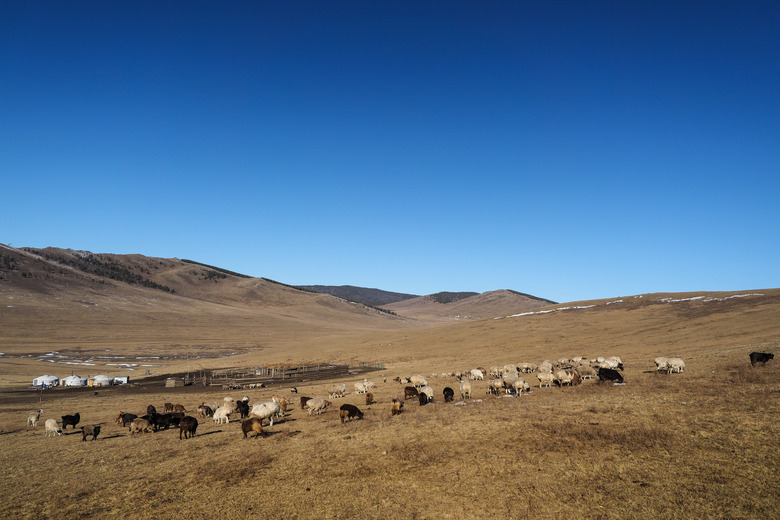Types Of Terrestrial Ecosystems
An ecosystem is a community of living organisms and nonliving objects that are interrelated. An ecosystem is not limited by size. For instance, a fish tank and a lake are both examples of an ecosystem. Terrestrial ecosystems, as the root "terr" implies, are those systems occurring on land, as opposed to marine ecosystems, which deal with the oceans. There are four major types of terrestrial habitat.
Forests
Forests
Forests can be divided further into four different subgroups, but all these terrestrial ecosystems have a dense tree population and medium to high levels of precipitation in common. Tropical rain forests are home to a great diversity of animals. The climate is hot with excessive rainfall, and vegetation grows in several layers from the forest floor to the canopy. The forests of India and eastern Brazil, however, have specific seasons of rain and dry weather. These forests are called tropical deciduous forests. Coastal coniferous and temperate deciduous forests flank the west and east coasts of the U.S., respectively. They experience four seasons, and only moderate rainfall. Temperate rain forests also occur along the northwest coast of North America. The northern Canadian forests are predominately coniferous and experience long sub-arctic winters.
Grasslands
Grasslands
In a grassland ecosystem, trees are scarce, removed by environmental conditions and brush fires (though single trees and a few tree stands do survive). However, the grasslands, as their name indicates, receive sufficient precipitation to sustain different varieties of grasses. Today, many grasslands are becoming endangered because of farming practices and grazing herds of animals, especially when overgrazing occurs. The grasslands are subdivided into tropical grasslands (also known as the savannas); temperate grasslands, like the prairies of the Midwest in the United States; and the polar grasslands like the northern Canadian tundra. Savannas generally receive 20 to 50 inches of rain per year, concentrated in a six to eight-month span, followed by a dry season. Temperate grasslands have hot summers and cold winters, with average annual rainfalls between 20 and 35 inches. Some sources categorize tundra as a separate terrestrial ecosystem. Tundra, whether arctic or alpine, typically are very cold with little rain.
Deserts
Deserts
Deserts are ecosystems with hardy inhabitants, able to survive in an environment that receives less than 10 inches (25cm) of rainfall annually. Deserts may be hot or cold. The desert is home to many plants that lie dormant until it rains, when they bloom and spread their seeds, which then lie dormant until the next major rainfall. It is also home to plants capable of storing their own water, such as cacti. Other plant adaptations in deserts include widespread roots and small leaves with waxy coverings. In hot deserts, some desert animals survive the searing heat by burrowing or living in caves. Many animals are largely nocturnal, staying underground during the heat of the day and foraging for food at night when it is cooler.
Mountains
Mountains
Mountainous ecosystems can often be home to several smaller terrestrial ecosystem examples, including meadows or forest regions. Because of steep elevation changes between peaks and valleys, mountainous regions can be quite varied in their climates, providing microclimates that can develop different terrestrial environment examples. Some mountain ranges, like the Rocky Mountains of North America and the Andes in South America, extend for thousands of miles. Other mountains are more isolated, developing ecosystems of much more limited extent. Mountain regions are quite sensitive to human impact.
Terrestrial Ecosystem vs Aquatic Ecosystem
Terrestrial Ecosystem vs Aquatic Ecosystem
Terrestrial ecosystems are just a part of the planet. Aquatic ecosystems such as oceans, lakes and rivers also host innumerable plant and animal species. The two spheres together offer a complete picture of the interdependence and coexistence of life on our planet.
Cite This Article
MLA
Buller, Melody. "Types Of Terrestrial Ecosystems" sciencing.com, https://www.sciencing.com/types-terrestrial-ecosystems-5516822/. 22 November 2019.
APA
Buller, Melody. (2019, November 22). Types Of Terrestrial Ecosystems. sciencing.com. Retrieved from https://www.sciencing.com/types-terrestrial-ecosystems-5516822/
Chicago
Buller, Melody. Types Of Terrestrial Ecosystems last modified August 30, 2022. https://www.sciencing.com/types-terrestrial-ecosystems-5516822/
